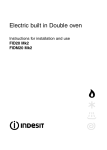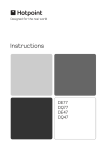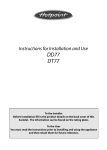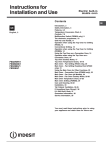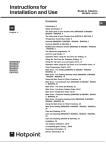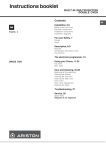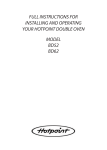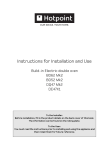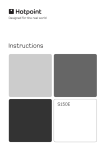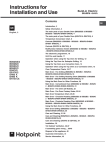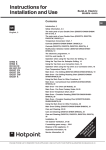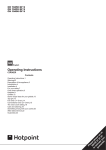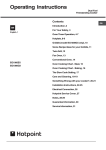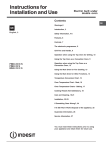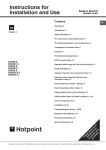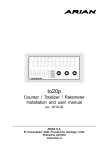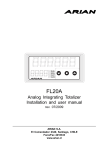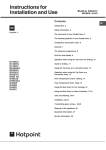Download Indesit FIMD 23 WH S
Transcript
Instructions for Installation and Use Electric built-in double oven Contents GB English, 2 Introduction, 2 Safety Information, 3-4 Installation, 5 Tall Cabinet Ventilation, 6-7 Features, 8-9 Temperature Conversion Chart, 10 Controls, 11-12 FID10IX/1 S-FIMDE23 IX S-FIMD 13 IX S ), 13 The electronic programmer, 14 Grill Pan and Handle, 15 Operation when using the Top Oven for Grilling DID 10 IX/1 FID10IX/1 S FIMD E 23 IX S FIMD 23 IX S FIMD 23 S FIMD 13 IX S BIMDS 23 B IX S BIMDS 23 IX GB S DID 10 IX/1 FID10IX/1 S-FIMD23 IX S-FIMD13 IX S- BIMDS23IXGB SBIMDS23IX S, 16 Conventional Grilling, 17 Operation when using the Top Oven for Grilling (FIMDE23 IX S), 18 Using the Top Oven as a Convection Oven, 19 Operation when using the Top Oven as a Convection Oven, 20 Top Oven Cookery Notes, 21 Top Oven Temperature Charts, 22-23 Main Oven - Fan Grilling (FIMDE23 IX S only), 24 Main Oven - Fan Grilling Roasting Chart (FIDM20,FIMDE23only), 25 Using the Main Oven for Other Functions, 26 Main Oven - Convention Oven (FIMDE23 IX S), 27 Main Oven - Fan Oven (all Models), 28 Main Oven - Fan Oven Cookery Notes, 29-30 Main Oven Temperature Chart, 31-32 Main Oven Grilling (FIMDE23 IX S), 33 Care and Cleaning, 34-36 If Something Goes Wrong?, 37 If it Still Won't Work/ Disposal of the appliance, 38 Guarantee Information, 39 Service Information, 40 You must read these instructions prior to using your appliance and retain them for future use. GB Safety Information • During use the appliance becomes hot. Care should be taken to avoid touching heating elements inside the oven. • WARNING: Accessible parts may become hot during use. Young children should be kept away. • Do not use harsh abrasive cleaners or sharp metal scrapers to clean the oven door glass since they can scratch the surface, which may result in shattering of the glass • When cleaning the appliance do not use steam cleaner. • WARNING: Ensure that the appliance is switched off before replacing the lamp to avoid the possibility of electric shock • The appliance is not intended to be operated by means of an external timer or separate remote-control system. ! VERY HOT SURFACES FOOD OR GREASE ON THESE SURFACES COULD CAUSE SMOKE AND POSSIBLY EVEN BURN YOU MUST KEEP THE OVEN AND GRILL CAVITIES CLEAN ! ATTENTION DURING INSTALLATION THE FEET OF THE APPLIANCE MUST BE LOWERED SO THAT AN AIR GAP OF AT LEAST 10MM (1CM) IS LEFT BETWEEN THE BASE OF THE APPLIANCE AND THE FLOOR. 10 mm GB • WARNING: The appliance and its accessible parts become hot during use. • Care should be taken to avoid touching heating elements. • Children less than 8 years of age shall be kept away unless continuously supervised. • This appliance can be used by children aged from 8 years and above and persons with reduced physical, sensory or mental capabilities or lack of experience and knowledge if they have been given supervision or instruction concerning use of the appliance in a safe way and understand the hazards involved. Children shall not play with the appliance. Cleaning and user maintenance shall not be made by children without supervision • ! When you place the rack inside, make sure that the stop is directed upwards and in the back of the cavity. ! ATTENTION WHEN USING THE MAIN OVEN YOU MUST ENSURE THAT THE BASE OF THE CAVITY IS NOT COVERED WITH ALUMINUM FOIL, UTENSIL OR ANY OTHER FORM OF COVERING. FAILURE TO DO THIS MAY RESULT IN THE CAVITY BEING DAMAGED. 2 Introduction Your new appliance is guaranteed* and will give lasting service.This guarantee is only applicable if the appliance has been installed in accordance with the installation instructions detailed in this booklet. To help make best use of your cooking equipment, please read this booklet carefully. The cooker is designed specifically for domestic use and responsibility will not be accepted for use in any other installation. Top Oven When the cooker is first used an odour may be emitted, this will cease after a period of use. DID 10 IX/1 When first using the cooker ensure that the room is well ventilated (e.g. open a window or use an extractor fan) and that persons who may be sensitive to the odour avoid any fumes. It is suggested that any pets be removed from the room until the smell has ceased. This odour is due to temporary finish on oven liners and elements and also any moisture absorbed by the insulation. * The guarantee is subject to the provisions that the appliance: (a) Has been used solely in accordance with the Users Instruction Book. (b) Has been properly connected to a suitable supply voltage as stated on the rating plate attached to this equipment. (c) Has not been subjected to misuse or accident or been modified or repaired by any person other than the authorised employee or agent. (d) Has been correctly installed. Technical Characteristics BIMDS 23 IX GB S FIMD 23 S FIMD E 23 IX S FIMD 23 IX S BIMDS 23 B IX S GB Usable Volume: 39 Litres FID10IX/1 S Usable Volume: 42Litres FIMD 13 IX S ENERGY LABEL AND ECODESIGN - Top Oven Regulation (EU) No 65/2014 supplementing Directive 2010/30/EU. Regulation (EU) No 66/2014 implementing Directive 2009/125/EC. Standard EN 60350-1 Standard EN 50564. Declared energy consumption for Natural convection Class heating mode: Conventional Main Oven BIMDS 23 B IX S FIMD 23 S FIMD 23 IX S BIMDS 23 IX GB S FIMD E 23 IX S Usable Volume: 71 Litres DID 10 IX/1 FIMD 13 IX S FID10IX/1 S Usable Volume: 74 Litres ENERGY LABEL AND ECODESIGN - Main Oven Regulation (EU) No 65/2014 supplementing Directive 2010/30/EU. Regulation (EU) No 66/2014 implementing Directive 2009/125/EC. Standard EN 60350-1 Standard EN 50564. Declared energy consumption for Natural convection Class This appliance conforms with the following European Economic Community directives: - - EC of 12/12/06 (Low Voltage) and 2006/95/EC subsequent modifications; EC of 15/12/04 (Electromagnetic 2004/108/EC Compatibility) and subsequent modifications; EC of 30/11/09 (Gas) and subsequent 2009/142/EC modifications (only for models which use gas); EEC of 22/07/93 and subsequent 93/68/EEC modifications. EC 2002/96/EC 1275/2008 Stand-by/ Off mode heating mode: Fan Oven Voltage and Frequency 230-240V~ 50Hz 3 For Your Safety GB When used properly your appliance is completely safe but as with any electrical product there are certain precautions that must be observed. PLEASE READ THE PRECAUTIONS BELOW BEFORE USING YOUR APPLIANCE. Always • • • • • • • • • • • • • • • • Always make sure you remove all packaging and literature from inside the oven and grill compartments before switching on for the first time. Always make sure you understand the controls prior to using the appliance. Always keep children away from the appliance when in use as the surfaces will get extremely hot during and after cooking. Always make sure all controls are turned off when you have finished cooking and when not in use. Always stand back when opening an oven door to allow any build up of steam or heat to disperse. Always use dry, good quality oven gloves when removing items from the oven/grill. Always take care to avoid heat/steam burns when operating the controls. Always turn off the electricity supply at the wall switch before cleaning and allow the appliance to cool. Always make sure the shelves are in the correct position before switching on the oven. Always keep the oven and grill doors closed when the appliance is not in use. Always take care when removing utensils from the top oven when the main oven is in use as the contents may be hot. Always keep the appliance clean as a build up of grease or fat from cooking can cause a fire. Always follow the basic principles of food handling and hygiene to prevent the possibility of bacterial growth. Always keep ventilation slots clear of obstructions. Always refer servicing to a qualified appliance service engineer. During use the oven becomes hot. Care should be taken to avoid touching heating elements inside the oven. SAFETY ADVICE IN THE EVENT OF A CHIP PAN OR ANY OTHER PAN FIRE: 1. TURN OFF THE COOKER APPLIANCE AT THE WALL SWITCH. 2. COVER THE PAN WITH A FIRE BLANKET OR DAMP CLOTH, this will smother the flames and extinguish the fire. 4 3. LEAVE THE PAN TO COOL FOR AT LEAST 60 MINUTES BEFORE MOVING IT. Injuries are often caused by picking up a hot pan and rushing outside with it. NEVER USE A FIRE EXTINGUISHER TO PUT OUT A PAN FIRE as the force of the extinguisher is likely to tip the pan over. Never use water to extinguish oil or fat fires. Never • • • • • • • • • • • • • Never leave children unsupervised where a cooking appliance is installed as all cooking surfaces will be hot during and after use. Never allow anyone to sit or stand on any part of the appliance. Never store items above the appliance that children may attempt to reach. Never remove the oven shelves whilst the oven is hot. Never heat up unopened food containers as pressure can build up causing the container to burst. Never store chemicals, food stuffs or pressurised containers in or on the appliance, or in cabinets immediately above or next to the appliance. Never operate the grill with the door closed as this will cause the appliance to overheat. Never use the appliance as a room heater. Never use the grill to warm plates. Never dry any items on the oven doors. Never install the appliance next to curtains or other soft furnishings. Never allow children to play with the appliance controls. Never use 'steam cleaners'. Children should be supervised to ensure that they do not play with the appliance. ! The appliance should not be operated by people (including children) with reduced physical, sensory or mental capacities, by inexperienced individuals or by anyone who is not familiar with the product. These individuals should, at the very least, be supervised by someone who assumes responsibility for their safety or receive preliminary instructions relating to the operation of the appliance. !The appliance must be used by adults only for the preparation of food, in accordance with the instructions outlined in this booklet. Any other use of the appliance (e.g. for heating the room) constitutes improper use and is dangerous. The manufacturer may not be held liable for any damage resulting from improper, incorrect and unreasonable use of the appliance. Installation Electrical Requirements For your own safety, we recommend that your cooker is installed by a competent person such as one who is registered with NICEIC (National Inspection Council for Electrical Installation Contracting). The cooker should be installed in accordance with the latest edition of the IEE Regulations. Warning: This appliance must be earthed. Electrical Connections The installer must check that the voltage shown on the rating plate corresponds with the house electricity supply. The cooker must be supplied via a suitable double pole isolating switch, having a contact separation of at least 3mm in all poles placed in a readily accessible position adjacent to the cooker. If the cooker is to be wired into a connector unit, this may be positioned behind the cooker providing the following requirements are met: i) The connector unit must not project from the wall more than 25mm. ii) The top of the connector must not be more than 130mm above floor level. Remove the terminal cover at the rear base of the cooker. Pass the cable through the cable clamp and connect to the appropriate terminals provided. Allow sufficient cable for any future servicing. Tighten the screws on the cable clamp and replace the cover. Make main connections in the connector unit or cooker control unit. This appliance conforms to B.S. EN 55014 regarding suppression of Radio and Television reception interference. A double Pole control switch having a minimum rating of 32 amps should be used to feed the cooker using a suitably rated cable. Where a hob is fitted adjacent to or over the cooker, a 45 amp Double Pole control switch should be used to feed both units via separate suitably rated cables. We recommend a minimum of 4mm2 PVC insulated twin and earth cable conforming to B.S. 6004 for connection of each appliance. In all cases adhere to routing details (see fig. 4). This appliance must not be installed over any other appliance that generates heat such as a plinth heater. Note: Due to many different types of installation, a mains cable is not supplied with this product. The installer will fit the correct type and length of cable. Important It is essential that the lower cupboard is constructed in the manner illustrated i.e. having side, back, and roof panels so joined as to provide no apertures which could permit access to the oven unit when installed. 1. General The appliance is designed for mounting at a safe level into an oven housing which must be secured to the backing wall. 2. Ventilation a. The oven housing unit cabinet dimensions must comply with fig. 4. b. An air gap of 50mm minimum must be provided at the rear of any top or bottom cupboards or shelves (see fig. 1). c. It is necessary that the cabinets are provided with unobstructed ventilation, i.e. from adjacent cabinetry. This can be done by either raising the base of the cabinets using the adjusting feet (or spacers) or alternatively by providing a slot in the cabinet plinth to the dimensions in fig. 1. d. The air gap at rear allows the warmed air to pass out of the inner cabinet space. Where it is intended to fit cupboards above the oven unit to ceiling height, it is essential that the warmed air is exhausted through the front of the cabinet (see fig. 1). e. If an oven unit is installed adjacent to a tall cabinet, steam escaping from the oven when the door is opened could condense on and maybe stain the adjacent surface. To prevent permanent staining, the adjacent surface should be made of a material that is heat resisting and easy to clean. Adjacent tall cabinets should not be deeper than the oven housing cabinet. 3. Final Installation a. Using a spirit level, check that the housing cabinet is level from side to side and from front to back in its installed position. b. Correct any unevenness by placing spacers under the bottom of the cabinet. Make sure that the cabinet rests firmly on the floor without rocking. c. Before the oven is fitted, the cabinet must be firmly secured to the backing wall for stability. d. The oven unit should now be lifted (this is a two person lift) into the cabinet and pushed fully home. e. Finally, the oven is secured to the cabinet by means of the four Phillips C/SK Head screws - two through each side trim. f. Remove all packaging material from the grill and oven interior. List of loose items: 4 x Phillips C/SK Head No. 6 x 25mm screws. 5 GB Tall Cabinet Ventilation GB Fig. 1 Ventilation Slot required here if cabinet does not fit to ceiling - 51mm x 457mm min. area 50 mm Air Gap Ventilation Slot required here if the cabinet does not fit to the ceiling - 51mm x 457mm min. area 50 mm Air Gap Ventilation Slot required here - 51mm x 457mm min. area 6 GB 562mm 570mm ndle exc. ha b o kn s Viewed down through cabinet 561 mm Cabinet 882mm No. 6x25mm screw (4 supplied) Fig. 3 870mm Oven Door 595 mm mm 550 Fig. 2 562 882mm, 870mm if cooker trim is to overlap top edge of shelf mm Connector Box mm 550 * min Fig. 4 4mm2 Cable To Oven 6mm2 Cable if hob fitted 4mm2 Cable to Hob if if fitted * excluding pipe work and other projections 7 Features DID 10 IX/1 FID10IX/1 S FIMD 23 IX S FIMD 23 S FIMD 13 IX S GB BIMDS 23 B IX S BIMDS 23 IX GB S WARNING: DO NOT TOUCH THE GLASS DOORS WHEN THE OVEN IS IN USE AS THESE AREAS CAN BECOME HOT. TOP OVEN TEMPERATURE CONTROL TOP OVEN/GRILL PILOT LIGHT TOP OVEN THERMOSTAT LIGHT TIMER MAIN OVEN TEMPERATURE & FUNCTION CONTROL MAIN OVEN THERMOSTAT LIGHT GRILL SETTING CONTROL GRILL ELEMENT GRILL PAN & FOOD SUPPORT MODEL & SERIAL NUMBER CATALYTIC LINER (FID20 ONLY) GRILLSHELF TOP OVEN DOOR OVEN LIGHT FAN GRILL ELEMENT OVEN SHELF OVEN FAN CATALYTIC LINER (FID20 ONLY) INNER DOOR GLASS MAIN OVEN DOOR NEVER line the shelves, floor or sides of the oven or grill with aluminium foil as overheating and damage may result. 8 Features FIMD E 23 IX S WARNING: DO NOT TOUCH THE GLASS DOORS WHEN THE OVEN IS IN USE AS THESE AREAS CAN BECOME HOT. TOP OVEN/GRILL PILOT LIGHT GRILL SETTING CONTROL GRILL ELEMENT GRILL PAN & FOOD SUPPORT GB TOP OVEN MAIN OVEN TEMPERATURE TEMPERATURE CONTROL CONTROL TOP OVEN THERMOSTAT MAIN OVEN THERMOSTAT LIGHT TIMER LIGHT MULTIFUNCTION SELECTOR MODEL & SERIAL NUMBER GRILL SHELF CATALYTIC LINER TOP OVEN DOOR MAIN OVEN LIGHT FAN GRILL ELEMENT OVEN SHELF OVEN FAN CATALYTIC LINER INNER DOOR GLASS MAIN OVEN DOOR NEVER line the shelves, floor or sides of the oven or grill with aluminium foil as overheating and damage may result. 9 Temperature Conversion Chart GB The chart below gives details of comparisons of oven settings for gas conventional ovens and fan oven in degrees °F and °C Conventional Oven Fan Oven Gas Mark 10 °F °C °C ½ 250 120 100 1 275 140 120 2 300 150 130 3 325 160 140 4 350 180 160 5 375 190 170 6 400 200 180 7 425 220 200 8 450 230 210 9 475 240 220 Controls DID 10 IX/1 FID10IX/1 S FIMD 23 IX S FIMD 23 S FIMD 13 IX S BIMDS 23 B IX S BIMDS 23 IX GB S A GRILL SETTING CONTROL GB TOP OVEN THERMOSTAT LIGHT TIMER MAIN OVEN THERMOSTAT LIGHT TOP OVEN/GRILL PILOT LIGHT B TOP OVEN TEMPERATURE CONTROL Control Knob Description C MAIN OVEN TEMPERATURE AND FUNCTION CONTROL Function Selects the heat at which the grill will cook the food. A Grill Setting Control B Top Oven Temperature Control min - max Grill Control Settings: Min = Low, Max = High Selects the cooking temperature (Degrees Centigrade) when using the top oven as a conventional oven. Fan Only Setting - This is used to decrease the amount of time required to defrost food items. C Main Oven Temperature & Function Control Oven Light Only - Switches on the Main Oven Interior Light Only Main Oven Temperature Scale (In Degrees Centigrade). - When cooking select the required cooking temperature. Cooling Fan A gentle flow of air will be blown below the control panel when the grill control is used and after a short period of time when the ovens are used. Note: Whenever the appliance has been used, the cooling fan may run on or restart itself after all the controls have been turned off. This indicates that the appliance is still warm. Slow Cooking The main oven has a "Slow Cook Setting" this can be used for slow cooking, keeping food warm and warming plates for a short period. Note: It is advisable to check that all oven controls have been switched off when you have finished using the appliance. Oven Interior Lights The oven lights are operated when their respective oven control is used. (N.B. Not all models have a top oven interior light). The main oven has a light only position. 11 Controls FIMD E 23 IX S TOP OVEN THERMOSTAT LIGHT GB TIMER MAIN OVEN THERMOSTAT LIGHT TOP OVEN/GRILL PILOT LIGHT B TOP OVEN TEMPERATURE CONTROL A GRILL SETTING CONTROL D MULTIFUNCTION SELECTOR C MAIN OVEN TEMPERATURE CONTROL IMPORTANT Before using your oven in the ordinary way, ALWAYS make sure that the timer has been set to MANUAL operation. Unless this is done, the main oven cannot heat up. Before seeking assistance, make sure this is done (refer to oven timer operation). TOP OVEN TEMPERATURE CONTROL Turn the control clockwise to set the top oven thermostat to the required temperature. An indicator light will illuminate. This will remain on until the oven reaches the required temperature. This light will then cycle on and off as the thermostat maintains control of the oven thermostat. MULTIFUNCTION SELECTOR Rotate the control knob in either direction to the required function. Many of the functions will also require the main oven thermostat to be set before the oven will heat up. GRILL CONTROL The grill control is designed to provide variable heat control of either both grill elements on together or the single left-hand grill element only. To set the grill power, turn the grill control: - clockwise for FULL grill to any setting MIN - MAX, or - anti-clockwise for HALF grill to any setting MIN MAX. MAIN OVEN TEMPERATURE CONTROL This is used in addition to the multifunction selector. This is used for the functions: fan oven, fan grill, half grill and full grill and convection oven. Turn the control clockwise to set the oven thermostat to the required temperature. If the timer is set correctly and the selector switch set to a suitable function an indicator light will illuminate (Fan Oven, Convection Oven and Fan Grilling modes only). This will remain on until the oven reaches the required temperature. This light will then cycle on and off as the thermostat maintains control of the oven temperature. 12 COOLING FAN A gentle flow of air will be blown below the control panel when the grill control is used and after a short period of time when the ovens are used. Note: Whenever the appliance has been used, the cooling fan may run on or restart itself after all the controls have been turned off. This indicates that the appliance is still warm. Multifunction Selector Switch FIMD E 23 IX S The Multifunction selector switch is used when operating the main oven. With the exception of the O position the main oven light will remain on when this selector switch is used. Off Light Only GB This function switches on the oven light only. ! After selecting any of the oven programs, the parameter setting of the product is activated. It optimizes the performance of cooking, but could result in a delayed ignition of fan and heating elements. With the selector in this position the main oven will not heat up. The timer will still operate. Fan Oven The oven fan and a rear element are controlled when this function is selected. Use the main oven thermostat control to set the required temperature. Conventional Oven Top and base elements are controlled when this function is selected. Use the main oven thermostat to set the required temperature. Half Grill With this function selected both sides of the grill will be on, but the outer element is switched off. Use the oven thermostat control to set the required temperature. Oven door must be open for grilling. Full Grill Both left and right hand grill elements will be on in this position. Use the oven thermostat control to set the required temperature. Oven door must be open for grilling. Fan Grill The oven fan and fan grill element are controlled when this function is selected. Use the oven thermostat control to set the required temperature. Oven door must be closed for fan grilling. Fan Only The oven fan will operate when this function is selected. The oven thermostat control must be set in the off position. 13 The electronic programmer Programming cooking GB ! A cooking mode must be selected before programming can take place. DISPLAY END OF COOKING icon DURATION icon •• •• DECREASE TIME button CLOCK icon Programming the cooking duration TIMER icon button several times until the icon 1. Press the and the three digits on the DISPLAY begin to flash. 2. Use the “+” and “-” buttons to set the desired duration; if you press and hold either button, the display will scroll through the values more quickly, making it quicker and easier to set the value. INCREASE TIME button SET TIME button ! The Main Oven (only) can be controlled by the automatic timer. ! Never operate the grill or top oven when the main oven is set to cook automatically because the oven cavity can become warm and this may cause bacterial growth in food. Setting the clock ! The clock may be set when the oven is switched off or when it is switched on, provided that the end time of a cooking cycle has not been programmed previously. After the appliance has been connected to the mains, 3. Wait for 10 seconds or press the button again to finalise the setting. 4. When the set time has elapsed, the text END appears on the DISPLAY, the oven will stop cooking and a buzzer sounds. Press any button to stop the buzzer and turn all control knobs to the 0 position. • For example: it is 9:00 a.m. and a time of 1 hour and 15 minutes is programmed. The programme will stop automatically at 10:15 a.m. Setting the end time for a cooking mode ! A cooking duration must be set before the cooking end time can be scheduled. or after a blackout, the icon and the four numerical digits on the DISPLAY will begin to flash. 1. Follow steps 1 to 3 to set the duration as detailed above. button several times until the icon 1. Press the and the four digits on the display begin to flash. 2. Use the “+” and “-” buttons to adjust the time; if you press and hold either button, the display will scroll through the values more quickly, making it quicker and easier to set the desired value. 2. Next, press the button until the icon and the four digits on the DISPLAY begin to flash. 3. use the “+” and “-” buttons to adjust the cooking end time; if you press and hold either button, the display will scroll through the values more quickly, making it quicker and easier to set the desired value. 3. Wait for 10 seconds or press the finalise the setting. 4. Wait for 10 seconds or press the button again to finalise the setting. 5. When the set time has elapsed, the text END appears on the DISPLAY, the oven will stop cooking and a buzzer sounds.Press any button to stop it. and buttons Programming has been set when the are illuminated. The DISPLAY shows the cooking end time and the cooking duration alternately. • For example: It is 9:00 a.m. and a duration of 1 hour has been programmed. 12:30 is scheduled as the end time. The programme will start automatically at 11:30 a.m. button again to Setting the minute minder ! This function does not interrupt cooking and does not affect the oven; it is simply used to activate the buzzer when the set amount of time has elapsed. 1. Press the button several times until the icon and the three digits on the display begin to flash. 2. Use the “+” and “-” buttons to set the desired time; if you press and hold either button, the display will scroll through the values more quickly, making it quicker and easier to set the value. 3. Wait for 10 seconds or press the button again to finalise the setting. The display will then show the time as it counts down. When this period of time has elapsed the buzzer will be activated. Cancelling a programme To cancel a programme: • • 14 press the button until the icon corresponding to the setting you wish to cancel and the digits on the display are flashing. Press the “-” button until the digits 00:00 appear on the display. Press and hold the “+” and “-” buttons; this will cancel all the settings selected previously, including timer settings. Grill Pan and Handle Using the grill pan kit The grill pan handle is detachable from the pan to facilitate cleaning and storage. Fix the pan handle securely before use: 1. Fit the handle to the grill pan so that the external ‘hooks’ embrace the edge of the pan (fig. 1) 2. Make sure that the middle part of the handle fits exactly the protruding support of the pan (fig .2) and holds the pan from the bottom. The food must be placed on the rack in the grill pan. Position the grill pan on top of the oven rack. The best results are achieved by placing the oven rack on the uppermost shelves. Pouring a little water into the grill pan will make the collection of grease particles more efficient and prevent the formation of smoke. 1 Grill Pan, Food Support 2 Top Oven Shelf Positioning for Grilling GB ENSURE SHELVES ARE FITTED CORRECT WAY UP. 3 2 1 3 2 1 DO NOT PLACE FOOD/UTENSILS DIRECTLY ON THE OVEN FLOOR NOTE: - Preheat the grill if indicated on grill chart. - The grill pan must be placed on the correct shelf and positioned centrally under the grill element. - Leave the control at MAX for toast, and for fast cooking of foods. - For thicker foods requiring longer cooking, turn the switch to a lower setting after the initial sealing on both sides at MAX. The thicker the food, the lower the control should be set. - DO NOT line the grill pan with aluminium foil, as this increases the amount of fat spitting which can cause a fire. - After use always return the grill control to the OFF (0) position. 15 Operation when using the Top Oven for Grilling DID 10 IX/1 FID10IX/1 S FIMD 23 IX S FIMD 23 S FIMD 13 IX S BIMDS 23 B IX S BIMDS 23 IX GB S GB A GRILL SETTING CONTROL TOP OVEN THERMOSTAT LIGHT TIMER TOP OVEN/GRILL PILOT LIGHT B TOP OVEN TEMPERATURE CONTROL Step 1 Ensure that the timer is set to manual. Step 2 Place the grill pan runner/support in the correct position (see Grilling Guide). Locate the grill pan in the runner/support, position centrally under the grill element. Leave the door fully open. Step 3 Turn knob (A) clockwise for FULL grill or anti-clockwise for HALF grill, to select the Grill Setting (min-max): MIN = Low, MAX = High) (MIN Grill Controls Example: = Maximum Grill Setting. NOTE: Step 4 Do not grill with the grill/top oven door closed. DOOR POSITION FOR GRILLING After use, turn the grill control (A) to the off position (•). ! The Top oven/Grill Pilot Light is on when grill is used. ! Ensure knob (B) is in "0 position". The grill and the top oven cannot work simultaneously DO NOT allow young children near to the appliance when the grill is in use as the surfaces get extremely hot. 16 Conventional Grilling CAUTION - ACCESSIBLE PARTS MAY BECOME HOT WHEN THE GRILL IS IN USE. CHILDREN SHOULD BE KEPT AWAY. GRILLING SHOULD NEVER BE UNDERTAKEN WITH THE GRILL/TOP OVEN DOOR CLOSED. The grill control is designed to provide variable heat control, either turning the control clockwise for the twin grill elements on together or turning anticlockwise for the single, left hand grill element only. You can select a power level of MIN through to MAX, in both directions. The control is Off at O. Note: The grill will not operate unless the top oven control is in the OFF position. Food which requires browning only should be placed under the hot grill, directly on the shelf in the first or second runner from the bottom of the oven, according to the depth of the dish. Open the grill door to the grilling position, ie. open fully. With the grill door in the grilling position, heating the grill is achieved by turning the control clockwise to the desired 'grill setting' on the control panel, as described under 'setting the grill'. Never: Line the grill pan with aluminium foil. Note: A gentle flow of air will be blown from underneath the controls by the coolong fan when the grill is in use and will continue to do so for a length of time even after the controls have been turned off. Preheat the grill at setting MAX for approximately 5 minutes. The grill pan is placed on the shelf and should be correctly positioned under the grill element. Leave the control at MAX for toast, sealing and fast cooking of foods. For thicker foods requiring longer cooking, turn the switch to a lower setting after the initial sealing on both sides at MAX. The thicker the food, the lower the control should be set. 17 GB Operation when using the Top Oven for Grilling FIMD E 23 IX S A GRILL SETTING CONTROL TOP OVEN THERMOSTAT LIGHT GB TIMER TOP OVEN/GRILL PILOT LIGHT B TOP OVEN TEMPERATURE CONTROL Step 1 Ensure that the timer is set to manual. Step 2 Place the shelf in the correct position (see Grilling Guide). Place the food/grill pan on the shelf, position centrally under the grill element. Leave the door fully open. Step 3 Turn knob (A) clockwise for FULL grill or anti-clockwise for HALF grill, to select the Grill Setting: MIN = Low, MAX = High) (MIN Grill Controls Example: = Maximum Grill Setting. NOTE: Step 4 Do not grill with the grill/top oven door closed. DOOR POSITION FOR GRILLING After use, turn the grill control (A) to the off position (•). ! The Top oven/Grill Pilot Light is on when grill is used. ! Ensure knob (B) is in "0 position". The grill and the top oven cannot work simultaneously DO NOT allow young children near to the appliance when the grill is in use as the surfaces get extremely hot. 18 Using the Top Oven as a Convection Oven The top oven should be used to cook small quantities of food. The oven is designed so that the grill element operates at a reduced heat output, this is combined with a heating element situated underneath the floor of the oven. To ensure even cooking of the food it is important that cooking utensils are positioned correctly on the oven shelf so that the element is directly above. As a guide, the front of the utensil should be approx.100mm (4") from the front of the shelf. GB Note: Charts are a guide only, to suit personal taste and requirements, it may be necessary to increase or decrease temperatures by 10°C. It may also be necessary to increase or decrease cooking times. SHELF POSITIONING ENSURE SHELVES ARE FITTED CORRECT WAY UP. 3 2 1 3 2 1 DO NOT PLACE FOOD/UTENSILS DIRECTLY ON THE OVEN FLOOR There should always be at least 25mm (1 inch) between the top of the food and the grill element. WARNING: Items stored in the top oven will get hot when the main oven is in use. DO NOT allow young children near to the appliance when the top oven is in use as the surfaces get extremely hot. 19 Operation when using the Top Oven as a Convection Oven A GRILL SETTING CONTROL GB TOP OVEN THERMOSTAT LIGHT TIMER TOP OVEN/GRILL PILOT LIGHT B TOP OVEN TEMPERATURE CONTROL Step 1 Step 2 Step 3 Step 4 Ensure that the timer is set to manual. Place the shelf in the correct position (see Oven Temperature Charts). Select the required cooking temperature (100°C-Max) using control (B) (see Top Oven Temperature Charts). The pilot light will immediately come on, and remain on until the oven reaches the required temperature. The thermostat light will then automatically go off and on during cooking as the oven thermostat maintains the correct temperature. Place the food centrally on the shelf below the element ensuring the oven door is closed. ! The Top oven/Grill Pilot Light is lit when top oven is used. NOTE: At the end of your cooking, always return control (B) to the OFF (O) position. 20 Top Oven Cookery Notes PLATE WARMING Place the plates/dishes on shelf position 1 from the base of the top oven, and turn top oven temperature control (B) to 100°C for 10-15 minutes. Never use the grill setting control (A) when warming plates. GB TOP OVEN UTENSILS Do Not use: Meat Pans and Baking Trays larger than - 225mm x 300mm (9"x12") DO NOT use the grill pan as a meat pan in the top oven, as the air circulation will be seriously restricted. 21 Oven Temperature Charts - Baking Top Oven Cooking GB Baking Pre-heat Temperature °C Time in mins. Position in Oven Scones Yes 210/220 10-15 Runner 2 from bottom of oven Small Cakes Yes 180/190 20-25 Runner 2 from bottom of oven Victoria Sandwich Yes 170/180 20-30 Runner 2 from bottom of oven Sponge Sandwich (fatless) Yes 180/190 20-25 Runner 2 from bottom of oven Swiss Roll Yes 200/210 10-15 Runner 2 from bottom of oven Semi-rich Fruit cakes Yes 150/160 60-75 7 inch Runner 1 or 2 from bottom of oven Rich Fruit Cakes Yes 140/150 Time Dependent on size Runner 1 or 2 from bottom of oven Shortcrust Pastry Yes 190/200 Time Dependent on recipe Runner 1 or 2 from bottom of oven Puff Pastry Yes 200/210 Time Dependent on recipe Runner 1 from bottom of oven Yorkshire Pudding Yes 190/200 30-40 Runner 1 or 2 from bottom of oven Individual Yorkshire Pudding Yes 200/210 20-30 Runner 1 from bottom of oven Milk Pudding Yes 140/150 90-120 Runner 1 from bottom of oven Baked Custard Yes 150/160 40-50 Runner 1 from bottom of oven Bread Yes 200/210 30-45 Runner 1 from bottom of oven Meringues Yes 100 150-180 Runner 2 from bottom of oven Fan Oven Cooking Baking Pre-heat Temperature °C Time in mins. Scones Yes 210/220 9-12 Small Cakes No 170/180 15-20 Victoria Sandwich No 160/170 20-25 Sponge Sandwich (fatless) Yes 190/200 15-20 Swiss Roll Yes 190/200 10-15 Semi-rich Fruit cakes No 140/150 1¼ - 1½ hrs Rich Fruit Cakes No 130/140 Depending on size Shortcrust Pastry No 190/200 Depending on size Puff Pastry No 190/200 Depending on size Yorkshire Pudding Yes 180/190 40-45 Individual Yorkshire Pudding Yes 190/200 20-25 Milk Pudding No 130/140 1½ - 2 hrs Baked Custard No 140/150 35-45 Bread Yes 200/210 30-35 Meringues No 80-90 3 - 4 hrs Note: If soft margarine is used for cake making, temperatures recommended by the manufacturers should be followed. Temperatures recommended in this chart refer to cakes made with block margarine only. 22 Oven Temperature Charts - Meat Top Oven Cooking Meat GB Pre-heat Temperature °C Time (approx.) Position in Oven Beef/ Lamb (slow roasting) Yes 170/180 35 mins per 450g (1lb) + 35 mins over. Beef/ Lamb (foil covered) Yes 190/200 35-40 mins per 450g (1lb) Pork (slow roasting) Yes 170/180 40 mins per 450g (1lb) + 40 mins over Pork (foil covered) Yes 190/200 40 mins per 450g (1lb) Veal (slow roasting) Yes 170/180 40-45 mins per 450g (1lb) + 40 mins over Veal (foil covered) Yes 190/200 40-45 mins per 450g (1lb) Poultry/Game (slow roasting) Yes 170/180 25-30 mins per 450g (1lb) + 25 mins over Poultry/Game (foil covered) Yes 190/200 25-30 mins per 450g (1lb) Casserole Cooking Yes 150 2-2½ hrs Runner 1 from bottom of oven. If using aluminium foil, never: 1.Allow foil to touch sides of oven. 2.Cover oven interior with foil. 3.Cover shelves with foil. Food Main Fan Oven Cooking Note: Up to two shelves may be used in this oven. The position of these is not important providing they are evenly spaced. Meat Pre-heat Temperature °C Time (approx.) Beef No 160/180 20-25 mins per 450g (1lb) + 20 mins extra. Lamb No 160/180 25 mins per 450g (1lb) + 25 mins extra. Pork No 160/180 25 mins per 450g (1lb) + 25 mins extra. Veal No 160/170 25-30 mins per 450g (1lb) + 25 mins extra Chicken/Turkey up to 4kg (8lb) No 160/180 18-20 mins per 450g (1lb) + 20 mins extra. Turkey up to 5.5kg (12lb) No 150/160 13-15 mins per 450g (1lb) eg. 5kg (11lb) = 143-165 mins Turkey over 5.5kg (12lb) No 150 12 mins per 450g (1lb) e.g. 10kg (22lb) = 264 mins Casserole Cooking No 140/150 1½ - 2 hrs The most accurate method of testing the readiness of joints of meat or whole poultry is to insert a meat thermometer into the thickest part of a joint, or the thickest part of poultry thighs, during the cooking period.The meat thermometer will indicate when the required internal temp has been reached. Beef Rare: 60°C Lamb: 80°C Poultry: 90°C Medium: 70°C Pork: 90°C Well Done: 75°C Veal: 75°C 23 Main Oven - Fan Grilling FIMD E 23 IX S GB Fan grilling is a combination of heat from the grill element and the oven fan circulating the hot air around the food. Joints of meat and poultry will be browned as if they were cooked on a rotisserie or spit but more economically as the door left closed. If required, fan grilling can be timed using the Oven Auto timer. Follow the timer instructions before selecting fan grill and the required temperature. If Manual fan grilling is required always ensure the timer is set to Manual. Operating Instruction 1. 2. 3. 4. Open the oven door. Select the correct shelf position, as stated in chart. Turn the selector switch to the Fan grill position. Turn the oven thermostat control to the required temperature (see Fan Grilling Roasting Chart, next page). 5. Position the meat pan centrally under the grill elements (if available). 6. Close the oven door. 7. After use always return both controls to the off position. 8. If the oven timer was used, reset to Manual. As with the fan oven cooking there is no need to preheat the oven - yet another economy feature. Also you can cook more than one thing at a time - even up to 4 small chickens. Temperatures These will be similar to those used for the more traditional form of roasting but the guide will give you an indication of which temperature to set the Thermostat. But remember that because of the way the oven is heated this is a more economical way of roasting. 24 General Recommendations Most types of meat and poultry cooked by this method will have an all over browness and crispness on the outside. The only exceptions are very lean joints, such as veal, which, because of its low fat content, is better cooked using conventional heating. 1. Always place the pan on the shelf position recommended. (See Chart). 2. There is no need to preheat the oven before cooking and all fan grilling should be carried out with the oven door closed, this saves energy. The cooking temperatures and times are calculated from a cold oven. 3. Position meat in oven as recommended in the roasting chart. 4. Fan grilling is ideally suited for cooking all types of poultry and larger joints of meat (e.g.stuffed, rolled joints and legs of pork and lamb). Results will be as if you had cooked the food on a rotisserie. If you use frozen meat or poultry it must be completely defrosted before it is cooked. 5. When cooking a joint always grill it with the fat side uppermost in order to crisp it. For bigger joints or where there is little bone, grill at the lower temperature given in the table and cook for a longer time per kg. 6. When cooking any type of poultry, start grilling the underside uppermost and turn breast uppermost about a third to halfway through the cooking period. If cooking stuffed poultry allow slightly longer cooking time. Main Oven - Fan Grilling Roasting Chart FIMD E 23 IX S Shelf positions are counted from the base upwards ie: lowest shelf position is 1. Temp °C Time (min/kg) PORK Pork Chop - thick 170 25 Dependente on size Gammon Steaks 160 30 Dependente on size 160-170 150-170 140-150 140-150 140 60-70 60-70 65-75 65-75 70-75 170 25 1.0 1.5 2.0 2.5 0ver 2.5 160-170 160-170 150-160 150-160 150 30-40 35-40 35-45 40-45 45-50 45 45 50 50 50 78-88 90-110 120-140 150-170 - Season. Grill on shelf position 3. Turn over after 15 mins. Score fat. Season with pepper and rosemary. If you prefer the lamb pink choose the shorter time Grill on shelf position 1. 1.0 1.5 2.0 2.5 over 2.5 170-180 170-180 160-170 160-170 160 40-50 40-50 40-50 45-50 45-50 20 20 20 30 40 60-70 80-90 100-110 140-150 - Season. If joint preferred rare grill for the shorter time. If preferred well done grill for the longer time. Grill on shelf position 1. 1.0 1.5 2.0 2.5 over 2.5 less than 1kg each 180 180 170 170 160-170 180 30 30 35 35 40 30 30 30 30 30 30 30 60 75 100 115 60 Season and brush over with melted butter to give nicely browned skin. Grill on shelf position 1. Shelf 1. DUCK 1.5 2.0 2.5 180 180 180 30 30 35 30 30 30 75 90 115-130 Dry thoroughly and lightly salt. Grill on shelf position 1. GOOSE up to 4 4-5 170-190 160-170 40 45 40 40 - Can be stuffed. Grill on shelf position 1 TURKEY up to 5 6 -8 170 150 - - 150-165 165-175 Season and brush over with melted butter to give nicely browned skin. Grill on shelf position 1. Any Any Any 170-180 170-180 170-180 30-50 40-50 40-50 - - Well hung meat will require less cooking time. grill on position 1. Beefburgers 450g(lb) 170 Sausages 450g(lb) 170 Bacon 450g(lb) 170 25mins per 450g (lb) 25mins per 450g (lb) 25mins per 450g (lb) Type of Meat or Poultry Pork - any type of joint Weight kg 1.0 1.5 2.0 2.5 over 2.5 LAMB Lamb chop - thick Lamb - any type of joint BEEF Beef - joints which have an outside layer of fat eg. Rib, Rolled, Sirloin CHICKEN Chicken joints GAME Grouse Partridge Pheasant Mixed Grill 170 Plus Extra Time (mins) 45 45 50 50 50 Total Cooking Time (mins) GB 105-120 130-150 180-230 220-240 - Dependent on size 30 Tips Season. Grill on shelf position 3. Turn over after 15 mins. Grill on shelf position 3 Turn after 15 mins. Score fat with sharp knife and rub on salt. Pork should always be thoroughly cooked. So overcook rather than undercook. Grill on shelf position 1. Shelf 3. Shelf 3. Prick sausages before cooking. Shelf 3. Roll up bacon before cooking. 4 pieces of steak, sausages, chops, bacon, tomatoes & mushrooms. Cook sausages, chops, bacon for 10 mins. add steak, cook for further 20 mins. 25 Using the Main Oven for Other Functions GB FAN ONLY SETTING DEFROSTING FROZEN MEAT & POULTRY Joints of meat and whole birds should be defrosted slowly, preferably in a refrigerator (allowing 5-6 hours per lb.) or at room temperature (allowing 2-3 hours per lb.). Frozen meat or poultry must be completely defrosted before cooking in the oven. However, to decrease the amount of time required to defrost food items, a nonheating fan only setting may be selected for the main oven only. OPERATION: TO ASSIST IN DEFROSTING: Place food in the oven and close the oven door. Turn Control (C or D, depending on your model) clockwise to the FAN ONLY setting: Control C - Model FID20, FIMD23, FID10, FIMD23, FIMD13,BIMDS23IXGB Control D - Model FIDM20,FIMDE23 This defrosts by circulating the air around the food, time to defrost will depend on type and size of the food. NOTES: DO NOT defrost meat and poultry by warming the food through. Foods ideally suited to defrosting using the fan only setting are cream/cream cakes, butter cream filled cakes, gateaux, cheese cakes, iced cakes, quiches, pastries, biscuits, bread, croissants, fruit and many delicate frozen foods. WARNING! The oven is provided with a stop system to extract the racks and prevent them from coming out of the oven.(1) As shown in the drawing, to extract them completely, simply lift the racks, holding them on the front part, and pull (2). 26 If fish, meat and poultry are to be defrosted using the fan only setting, where possible it is recommended that the food should be small and thin. The items should be placed so that the maximum amount of surface area is exposed to the circulating air, and that they are turned regularly to ensure even defrosting. Larger cuts of meat and poultry may be defrosted by using the fan only setting up to a maximum weight of 2 kg (4lb 8oz). It is important to wash both meat and poultry and cooking utensils immediately after defrosting and before cooking. Food should be cooked immediately after defrosting. It is very important to strictly adhere to the basic principles of food handling and hygiene to prevent the possibility of bacterial growth. LIGHT ONLY SETTING When Control (C or D, depending on your model) is turned clockwise to the LIGHT ONLY setting, the main oven light only will illuminate: Control C - Model FID20 Control D - Model FIDM20 Main Oven - Convention Oven FIMD E 23 IX S Important NEVER line the shelves, the floor or the sides of the oven with aluminium foil as overheating and damage may result. The oven is heated by elements at the top of the oven and underneath the floor of the oven. GB Food should not be placed on the floor of the oven Operating Procedure 1. Ensure Oven Timer is set to Manual. 2. Position rod shelf as recommended in the chart for food being cooked. 3. Position food centrally under grill element. 4. Turn the selector switch to the conventional oven position. 5. Turn the oven thermostat control to the required temperature setting (see oven temperature charts). The oven light will remain on. The oven indicator light will remain on until the oven reaches the set temperature. This light will then automatically cycle on and off during cooking as the oven temperature is controlled. 6. After use always return both controls to the off position and close the oven door. 27 Main Oven - Fan Oven (all Models) GB Important NEVER line the shelves, the floor or the sides of the oven with aluminium foil as overheating and damage may result. The oven is heated by elements at the rear of the oven. A fan at the rear of the oven operates to circulate heated air within the oven. Operating Procedure 1. Ensure Oven Timer is set to Manual. 2. Turn the selector switch to the fan oven position. 3. Turn the oven thermostat control to the required temperature setting (see Main Oven temperature charts). The oven light will remain on. The oven indicator light will remain on until the oven reaches the set temperature. This light will then automatically cycle on and off during cooking as the oven temperature is controlled. 4. After use always return both controls to the off position and close the oven door. 28 Main Oven - Fan Oven Cookery Notes Since a fan oven heats up more quickly, and generally cooks food at a lower temperature than a conventional oven, pre-heating the oven is often unnecessary. However, foods such as bread, scones, Yorkshire pudding, do benefit from being placed in a pre-heated oven. The charts are a guide only, giving approximate cooking temperatures and times. To suit personal taste and requirements, it may be necessary to increase or decrease temperatures by 10°C. Because the fan oven cooks so efficiently, we recommend that when cooking any recipes not designed for a fan oven, you reduce the temperature by about 25°C and the time by about 10 minutes in the hour. If large quantities are being cooked it will be necessary to increase the cooking time somewhat to compensate for the extra oven load. Unless otherwise indicated in the charts, food is placed in a cold oven, i.e. without preheating. If food is placed in an already hot oven, the suggested cooking time should be reduced, depending on the type and quantity of food being cooked. It should be noted that at the end of a cooking period there may be a momentary puff of steam when the oven door is opened, this will disperse in a few seconds and is a perfectly normal characteristic of an oven with a good door seal. Oven Positions Since the distribution of heat in the fan oven is very even, most foods will cook satisfactorily on any shelf position, but the shelves should be evenly spaced: To ensure even circulation do not use meat pans larger than 390x300mm (15ins x 12ins) and baking trays no larger than 330 x 255mm (13ins x 10ins), these should be positioned centrally on the oven shelf. - Do not fit shelves upside down. Never use more than 3 shelves in the oven as air circulation will be restricted. Food or cooking utensils should not be placed on the floor of the oven. To avoid unnecessary cleaning, rod shelves which are not in use should be removed from the oven. 29 GB Main Oven - Fan Oven Cookery Notes GB Temperature and Time The oven is provided with two shelves. A third is available as an optional extra, contact Genuine Parts and Accessories Hotline (see back page) for further information. If three shelves are used to cook large quantities of food for home freezing or parties, it may be necessary to increase the cooking times given in the charts by a few minutes, to allow for the loss of heat due to the extra time taken to load the oven, and the larger mass of food. Baking trays should allow an equal gap on all sides of the oven. To prepare meat and poultry for Roasting in your Fan Oven (a) Wipe the meat or poultry, dry well and weigh it. Meat which has for been stored in a refrigerator should be allowed to come to room temperature before cooking, and frozen meat or poultry must be completely defrosted before placing in the oven. (b) The weight of any stuffing used should be added before calculating the cooking time. (c) Small joints weighing less than 1.75kg (31/2 lbs) should be roasted in a smaller meat pan/tin - or they may be 'pot roasted' - a small joint or a large meat pan causes unnecessary oven splashing and evaporation of meat juices. (d) Additional fat should not be added, except for veal, very lean meat or poultry which can either be 'larded' with fat bacon or brushed very sparingly with cooking oil or melted fat. (e) Beef, lamb, mutton and poultry may be dusted lightly with seasoned flour to give a crisp outer surface. The skin of duck and goose should be pricked to release excess fat during cooking, and the rind of pork should be scored, brushed lightly with oil, and rubbed with salt to give crisp crackling. (f) Meat and poultry wrapped in, or covered with a tent of aluminium foil will be juicy and tender. Roasting bags offer the same advantages. Always follow the manufacturer's pack instructions, and remember to reduce the temperatures given for conventional ovens by approximately 25°C and the time by approximately 10 minutes per hour. (g) Potatoes for roasting only require to be brushed with cooking oil or melted fat. (h) It is not necessary to baste when roasting in an electric oven and stock or liquid should not be added to the meat pan since this only causes unnecessary soiling, steam and condensation. 30 Frozen Meat and Poultry Joints of meat and whole birds should be defrosted slowly, preferably in a domestic refrigerator (allowing 5-6 hours per 450g,1 lb), or at room temperature (allowing 2-3 hours per 450g, 1 lb). Frozen meat or poultry must be completely defrosted before placing in the oven. It is essential to wash thoroughly and cook meat and poultry immediately after defrosting. Main Oven Temperature Chart Conventional Oven (FIDM20, FIMDE23) GB It is not necessary to pre-heat the fan oven before roasting. Note: Where times are stated, they are approximate only. Meat Pre-heat Temperature °C Time (approx.) Beef/ Lamb (slow roasting) Yes 170/180 35 mins per 450g (1lb) + 35 mins over. Beef/ Lamb (foil covered) Yes 190/200 35-45 mins per 450g (1lb) Pork (slow roasting) Yes 170/180 40 mins per 450g (1lb) + 40 mins over Pork (foil covered) Yes 190/200 40 mins per 450g (1lb) Veal (slow roasting) Yes 170/180 40-45 mins per 450g (1lb) + 40 mins over Veal (foil covered) Yes 190/200 40-45 mins per 450g (1lb) Poultry/Game (slow roasting) Yes 170/180 25-30 mins per 450g (1lb) + 25 mins over Poultry/Game (foil covered) Yes 190/200 25-30 mins per 450g (1lb) Casserole Cooking Yes 150 2-2½ hrs Position in Oven Runner 2 or 3 from bottom of oven. If using aluminium foil, never: 1.Allow foil to touch sides of oven. 2.Cover oven interior with foil. 3.Cover shelves with foil. Fan Oven (FIDM20,FIMDE23) It is not necessary to pre-heat the fan oven before roasting. Note: Where times are stated, they are approximate only. Meat Pre-heat Temperature °C Time (approx.) Beef No 160/180 20-25 mins per 450g (1lb) + 20 mins extra. Lamb No 160/180 20-30 mins per 450g (1lb) +25 mins extra. Pork No 160/180 25-30 mins per 450g (1lb) +25 mins extra. Veal No 160/170 25-30 mins per 450g (1lb) +25 mins extra. Chicken/Turkey up to 4kg (8lb) No 160/180 18-20 mins per 450g (1lb) + 20 mins extra. Turkey 4 to 5.5kg (8 to 12lb) No 150/160 or 150 25-30 mins per 450g (1lb) Casserole Cooking No 140-150 1½ - 2 hrs Position in Oven Runner 2 or 3 from bottom of oven. If using aluminium foil, never: 1.Allow foil to touch sides of oven. 2.Cover oven interior with foil. 3.Cover shelves with foil. The most accurate method of testing the readiness of joints of meat or whole poultry is to insert a meat thermometer into the thickest part of a joint, or the thickest part of poultry thighs, during the cooking period.The meat thermometer will indicate when the required internal temp has been reached. Beef Rare: 60°C Lamb: 80°C Poultry: 90°C Medium: 70°C Pork: 90°C Well Done: 75°C Veal: 75°C 31 Main Oven Temperature Chart GB Baking Food Conventional Oven (FIDM20,FIMDE23) Pre-heat Temperature °C Time in mins. Shelf Position Scones Yes 220/230 10-15 2nd from bottom Small Cakes Yes 180/190 15-25 3nd from bottom Victoria Sandwich Yes 160/170 20-30 3nd from bottom Sponge Sandwich (fatless) Yes 170/180 15-20 3nd from bottom Swiss Roll Yes 190/200 8-12 3nd from bottom Semi-rich Fruit cakes Yes 150/160 1¼ hrs. 7" 2nd from bottom Rich Fruit Cakes Yes 130/140 Depending on recipe and size 2nd from bottom Shortcrust Pastry Yes 180/190 Depending on use 2nd or 3rd from bottom Puff Pastry Yes 190/200 Depending on use 2nd or 3rd from bottom Yorkshire Pudding Yes 190/200 40-45 3nd from bottom Individual Yorkshire Pudding Yes 200/210 20-30 3nd from bottom Milk Pudding Yes 140/150 1¼ - 2 hrs. 2nd from bottom Baked Custard Yes 130/140 40-50 3nd from bottom Bread Yes 190/200 25-35 3nd from bottom Meringues Yes 80/90 3 - 3½ hrs. 3nd from bottom Baking Food Fan Oven (FIDM20, FIMDE23) Pre-heat Temperature °C Time in mins. Shelf Position Scones Yes 210/220 9-12 approx. 2nd from bottom Small Cakes No 170/180 15-25 approx. 3nd from bottom Victoria Sandwich No 160/170 20-30 approx. 3nd from bottom Sponge Sandwich (fatless) Yes 180/190 15-20 approx. 3nd from bottom Swiss Roll Yes 190/200 12-15 approx. 3nd from bottom Semi-rich Fruit cakes No 140/150 1¼ - ½ hrs. approx. 2nd from bottom Rich Fruit Cakes No 130/140 Depending on size 2nd from bottom Shortcrust Pastry No 190/200 Depending on size 2nd or 3rd from bottom Puff Pastry No 190/200 Depending on size 2nd or 3rd from bottom Yorkshire Pudding Yes 180/190 40-50 approx. 3nd from bottom Individual Yorkshire Pudding Yes 190/200 20-25 approx. 3nd from bottom Milk Pudding No 130/140 1½ - 2 hrs. approx. 2nd from bottom Baked Custard No 140/150 35-45 approx. 3nd from bottom Bread Yes 200/210 30-35 approx. 3nd from bottom Meringues No 80/90 3 - 4 hrs. approx. 3nd from bottom Note: If soft tub margarine is used for cake making, we would recommend using the all in one method and to reduce the temperature by 10°C. Temperatures recommended in this chart refer to cakes made with block margarine or butter only. Note: Where times are stated, they are approximate only. 32 Main Oven Grilling FIMD E 23 IX S DO NOT allow young children near the appliance when the grill is in use as the surfaces can get extremely hot. GRILLING SHOULD NEVER BE UNDERTAKEN WITH THE DOOR CLOSED. - Do Not line the grill pan with aluminium foil. Ensure that the grill pan is cleaned after every use. Excess fat build-up in the bottom of the pan could cause a fire hazard. Preheat the grill on the required setting for 5 minutes Grilling Procedure: 1. Open the main oven door fully and position the rod shelf as recommended in the grilling chart (see below) for the food being cooked. 2. Turn the multifunction selector switch to HALF grill or FULL grill and then turn the Main Oven temperature control to the required setting to pre-heat for approximately 5 minutes. 3. Position the grill pan centrally under the grill element and push back as far as the location stops on the rod shelf. 4. Leave the oven thermostat at setting MAX for toast and for fast cooking of foods. For thicker foods requiring longer cooking turn the thermostat to a lower setting, after initial sealing on both sides at MAX. The thicker the food, the lower the thermostat should be set. If excessive smoke is emitted, reduce the setting. 5. After use always return both controls to their OFF (O) position. Shelf Position from base of oven Setting Required Temp °C Cooking Time 6 230 2-5 mins 5 or 6 230 for 4 - 6 mins then reduce to setting 170 10-20 mins Chops, gammon steaks etc. 5 230 for 6 - 8 mins then reduce to setting 170 20-30 mins Fish: Whole / Fillets Fingers 5 6 170 230 15-20 mins 10-15 mins Pizza's 5 170 10-15 mins Browning of food 5 230 5-10 mins Food Toasting of bread products Small cuts of meat, sausages, bacon etc. 33 GB Care and Cleaning GB Warning: Before cleaning, please ensure that the electricity supply to the appliance is switched off and the appliance is fully cold. ! Never use steam cleaners or pressure cleaners on the appliance. ! Clean the glass part of the oven door using a sponge and a non-abrasive cleaning product, then dry thoroughly with a soft cloth. Do not use rough abrasive material or sharp metal scrapers as these could scratch the surface and cause the glass to crack. ! The accessories can be washed like everyday crockery (even in your dishwasher). 1. CATALYTIC OVEN LINERS (Top Oven Sides, Main Oven Sides and Rear Panel) It should not normally be necessary to clean the panels with water. If the user feels it is desirable to do so, wipe them over with a clean, soapy cloth, followed by a wipe with a clean damp cloth. DO NOT use biological washing powder, harsh abrasives or chemical oven cleaners of any kind as this could damage the "Stayclean" oven liners. 2. CLEANING GRILL, TOP OVEN AND MAIN OVEN GRILL PAN OVEN SHELVES MAIN OVEN BASE BASE & REAR MEAT PAN TOP OVEN SIDES (a) Base & Rear of Top Oven and Base of Main Oven. Wipe out the oven with a damp soapy cloth. For more stubborn stains on the base of the oven use a well soaped fine steel wool soap pad. (b) Grill Pan & Oven Shelves. To prevent stains from being burnt on to the grill pan, food support and rod shelf, always wash immediately after use in warm soapy water. Use a well soaped fine steel wool soap pad to remove stubborn stains from the rod shelves and grill pan and the base of the oven. MAIN OVEN SIDES AND REAR PANEL (a) How catalytic oven liner works. The surfaces of the oven liners are treated with a special vitreous enamel which absorbs cooking soils. At temperatures of 220°C (425°F) or above, the special surface enables these soils to be slowly destroyed. The higher the temperature the more effective it is. (b) Cleaning. In most cases normal cooking operations at 220°C (425°F) will permit this cleaning operation to proceed during cooking. However if higher cooking temperatures are not used regularly, it may be necessary, in order to prevent heavy soiling, to run the ovens without shelves, at a maximum setting for a couple of hours. 34 DO NOT use aerosol cleaners on this oven as they could adversely affect the fan motor unit, and cannot be wiped off the fan blade. Care and Cleaning 3. OVEN DOORS 5. HOW TO CLEAN THE LAMP LENS GB CONTROL PANEL TOP OVEN LAMP (not all models) OVEN DOORS MAIN OVEN LAMP Warning: To avoid electric shocks - please ensure that the electricity supply to the appliance is switched off and the appliance is fully cold, before cleaning lamp lens. (a) Control Panel Regularly wipe with a clean, damp cloth and polish with a clean, dry cloth. (b) Inner Door Panels & Glass Open the door fully. The glass panel may now be washed. Stubborn stains can be removed by using a well soaped, fine steel wool soap pad. Open the oven door and remove the oven shelves. Using a thick cloth, grip the lamp lens, unscrew anticlockwise and remove. Clean with a non-abrasive cleansing cream and refit lamp lens. DO NOT use scouring pads, or abrasive powder, which will scratch the glass lens ! Do not use the oven lamp as/for ambient lighting (c) Stainless trims (SS models only) Regularly wipe with a clean, damp cloth and polish with a clean dry cloth. DO NOT use scouring pads, or abrasive powder, which will scratch the glass. 4. REPLACEMENT OF THE OVEN LAMP TOP OVEN LAMP (not all models) MAIN OVEN LAMP Warning: To avoid electric shocks - please ensure that the electricity supply to the appliance is switched off and the appliance is fully cold, before removing the lamp lens. Open the oven door and remove the oven shelves. Using a thick cloth, grip the lamp lens, unscrew anticlockwise and remove the lens. Carefully unscrew the bulb anti-clockwise. Fit replacement bulb (25W 300°C SES) and refit lens. 35 Care and Cleaning GB Take particular care not to damage the inner surface of the door inner glass that is coated with a heat reflective layer. Do not use scouring pads, or abrasive powder, which will scratch the glass. Ensure that the glass panel is not subjected to any sharp mechanical blows. Stubborn stains can be removed by using a fine steel wool pad. For slight soiling the inner glass panel may be cleaned, while still warm, without removing it from the door. After cleaning, rinse and dry with a soft cloth. CLEANING THE DOORS SIDE OPENING DOORS Cleaning the door glass is the same as the drop down doors, except take care to support the weight of the inner glass when removing and refitting. DROP DOWN DOORS Remove the door inner glass as follows. 1. Open the door fully and unscrew the two screws securing the glass panel so that the securing brackets can be turned. There is no need to remove the screws completely. 2. Turn the brackets so that the glass can be removed and cleaned at the sink (Fig. 1.). 3. The inside of the outer door glass can now be cleaned while still fitted to the cooker. NEVER OPERATE THE COOKER WITHOUT THE INNER DOOR GLASS IN POSITION. Refit the door inner glass as follows. 1. NOTE: The inner door glass has a special reflective coating on one side. Replace the door inner glass so that the statement: "IMPORTANT THIS FACE TOWARDS THE OVEN" can be read from the inner side of the door. 2. Turn the two securing brackets back to their original position to retain the glass and tighten the screws (Fig. 2.) 36 Respecting and conserving the environment • Whenever possible, avoid pre-heating the oven and always try to fill it. Open the oven door as little as possible because heat is lost every time it is opened. To save a substantial amount of energy, simply switch off the oven 5 to 10 minutes before the end of your planned cooking time and use the heat the oven continues to generate. • Keep gaskets clean and tidy to prevent any door energy losses • If you have a timed tariff electricity contract, the “delay cooking” option will make it easier to save money by moving operation to cheaper time periods. If Something Goes Wrong? Before calling a Service Engineer, please check through the following lists. THERE MAY BE NOTHING WRONG. GB Problem Check Slight odour or small amount of smoke when grill / oven used for first time This is normal and should cease after a short period. Nothing works If you find that the timer display is blank, then it is likely that there is no electricity supply to your oven. Check: (i) That the main cooker wall is switched on (ii) Other appliances, to see if you have had a power cut (iii) The main circuit breaker for the property Timer Display shows '0.00' with "Auto" Flashing The power supply to your oven has possibly been interrupted, but has now come back on again. Reset the timer to the correct day and "Manual" operation using the instructions given in the timer section of the book. Main oven and Top ovens do not work, but the grill works Your timer may be set for an Auto Cooking programme: Check the timer to see whether 'Auto' is lit or flashing. If it is then please follow the instructions given in the Timer section of this book to return the timer to Manual operation. Top oven and grill do not work, but Main oven works. Operating the cooker under the following conditions may cause a safety device to operate: (a) Grilling with the door closed - Always grill with the door fully open (b) Grilling for an excessively long period at maximum setting - see Grilling guide. Switch off appliance and allow to cool for approx 30 mins. Switch the cooker back on and check that the Grill / Top oven is now operating. Grill keeps turning on and off When the Grill control is operating at less than its maximum setting, the Grill will cycle on and off, this is normal and not a fault. Draught from beneath control panel A gentle flow of air will be blown from beneath the control panel when the appliance is used. If the appliance is still warm, this cooling fan may run on, or restart itself after all of the controls have been turned off. The fan will stop once the appliance has been cooled. This is normal and not a fault. Timer buzzer / audible tone operates continually To cancel the audible tone, press the minute minder button. Grilling is uneven Ensure that Grill pan has been positioned as stated in the Grilling section of this book. Oven does not cook evenly Check: (a) Temperature and shelf positions are as recommended in the Oven Temperature Charts. (b) Oven utensils being used allow sufficient air flow around them. Oven temperatures too high or low Check temperature and shelf positions are as recommended in the Oven Temperature Charts. It may be necessary to increase or decrease the recommended temperature slightly to suit your taste. Oven lamp does not work The oven lamp is not covered by the guarantee. The part is easily changed (see section on oven lamp replacement). A new lamp may be obtained from our Parts department (see back page). Condensation on the wall at the rear of the cooker. Steam and / or condensation may appear from the vent at the rear of the appliance when using an oven particularly for foods with a high water content e.g. frozen chips, roast chicken etc. This is normal, and any excess should be wiped off. Steam / Condensation in the oven after use. Steam is a by - product of cooking any food with a high water contact. To help minimise always: a) Try to avoid leaving food in the oven to cool after being cooked b) Use a covered container, wherever possible. 37 If it Still Won't Work GB Contact the Service Office If something is still wrong with your appliance after you have been through the 'Something Wrong' list: 1. Switch off and unplug the appliance from the mains. 2. Call your nearest Service Office or local importer. When you contact us we will want to know the following: 1. 2. 3. 4. Your name, address and postcode. Your telephone number. Clear and concise details of the fault. The Model number and the Serial number of your appliance. 5. The date of purchase (please keep the receipt as evidence will be required when an engineer calls) enter the date here: ............................................................................. Please make sure you have all these details ready when you call. Spare Parts Please remember your new appliance is a complex piece of equipment. 'DIY' repairs or unqualified and untrained service people may put you in danger, could damage the appliance and might mean you lose cover under the Parts Guarantee. If you do experience a problem with the appliance don't take risks, call in our Service Engineer. Our Parts are designed exclusively to fit your appliance. Do not use them for any other purpose as you may create a safety hazard. 38 Disposal of your product To minimise the risk of injury to children please dispose of your product carefully and safely. Remove all doors and lids. Remove the mains cable (where fitted) by cutting off flush with the appliance and always ensure that no plug is left in a condition where it could be connected to the electricity supply. To help the environment, Local Authority instructions should be followed for the disposal of your product. Disposal of old electrical appliances The European Directive 2002/96/EC on Waste Electrical and Electronic Equipment (WEEE), requires that old household electrical appliances must not be disposed of in the normal unsorted municipal waste stream. Old appliances must be collected separately in order to optimise the recovery and recycling of the materials they contain and reduce the impact on human health and the environment. The crossed out "wheeled bin" symbol on the product reminds you of your obligation, that when you dispose of the appliance it must be separately collected. Consumers should contact their local authority or retailer for information concerning the correct disposal of their old appliance. Guarantee GB 12 months Parts and Labour Guarantee Your appliance has the benefit of our manufacturer’s guarantee, which covers the cost of breakdown repairs for twelve months from the date of purchase. This gives you the reassurance that if, within that time, your appliance is proven to be defective because of either workmanship or materials, we will, at our discretion, either repair or replace the appliance at no cost to you. This guarantee is subject to the following conditions: - The appliance has been installed and operated correctly and in accordance with our operating and maintenance instructions. The appliance is used only on the electricity or gas supply printed on the rating plate. The appliance has been used for normal domestic purposes only. The appliance has not been altered, serviced, maintained, dismantled, or otherwise interfered with by any person not authorised by us. Any repair work must be undertaken by us or our appointed agent. Any parts removed during repair work or any appliance that is replaced become our property. The appliance is used in the United Kingdom or Republic of Ireland. The guarantee does not cover: - Damage resulting from transportation, improper use, neglect or interference or as a result of improper installation. Replacement of any consumable item or accessory. These included but not limited to: plugs, cables, batteries, light bulbs, fluorescent tubes and starters, covers and filters. Replacement of any removable parts made of glass or plastic. THIS GUARANTEE WILL NOT APPLY IF THE APPLIANCE HAS BEEN USED IN COMMERCIAL OR NONDOMESTIC PREMISES. 5 Year Parts Guarantee Indesit also offers you a free 5 year parts guarantee. This additional guarantee is conditional on you registering your appliance with us and the parts being fitted by one of our authorised engineers. There will be a charge for our engineer’s time. To activate the extra parts warranty on your appliance, simply call our registration line on 08448 24 24 24 (Republic of Ireland 01 230 0800) Extended Guarantees We offer a selection of protection plans that enable you to fully cover yourself against the expense of repair bills for the life of your policy. To find the ideal plan for you please call our advice line on 08448 226 226 (Republic of Ireland 01 230 0233). Free Helpdesk Service We have a dedicated team who can provide free advice and assistance with your appliance if you experience any technical difficulties within the first 90 days of ownership. Simply call our Indesit Service Hotline on 08448 224 224 (Republic of Ireland 0818 313 413) for telephone assistance, or, where necessary, to arrange for an engineer to call. 39 04/2014 - 195121665.00 XEROX FABRIANO After Sales Service GB No one is better placed to care for your Indesit appliance during the course of its working life than us – the manufacturer. Essential Contact Information Indesit Service We are the largest service team in the UK and Ireland offering you access to 400 skilled telephone advisors and 1000 fully qualified engineers on call to ensure you receive fast, reliable, local service. UK: 08448 224 224 Republic of Ireland: 0818 313 413 www.indesitservice.co.uk Please note: Our advisors will require the following information: Model number: Serial number: Parts and Accessories We supply a full range of genuine replacement parts as well as accessory products that protect and hygienically clean your appliance to keep it looking good and functioning efficiently throughout its life. UK: 08448 225 225 Republic of Ireland: 0818 313 413 www.indesitservice.co.uk Appliance Registration We want to give you additional benefits of Indesit ownership. To activate your free 5 year parts guarantee you must register your appliance with us. UK: 08448 24 24 24 Republic of Ireland: 01 230 0800 www.indesitservice.co.uk Indesit Company UK Ltd. Morley Way, Peterborough, PE2 9JB Indesit Company Unit 49 Airways Industrial Estate, Dublin 17 Recycling and Disposal Information As part of Indesit’s continued commitment to helping the environment, Indesit reserves the right to use quality, recycled components to keep down customer costs and minimise material wastage. Please dispose of packaging and old appliances carefully. To minimise the risk of injury to children, remove the door, plug, and cut the mains cable off flush with the appliance. Dispose of these parts separately to ensure that the appliance can no longer be plugged into mains socket, and the door cannot be locked shut. Indesit Company S.P.A. Viale Aristide Merloni,47 60044 Fabriano (AN) www.indesit.com 40








































